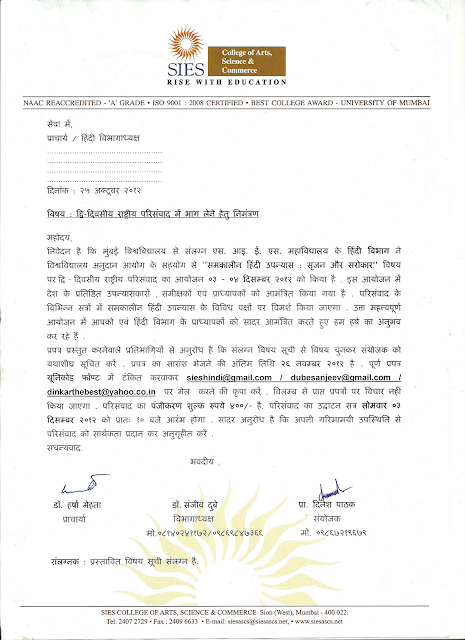International Conference on WEB MEDIA AND GLOBAL SCENARIO OF HINDI
11th & 12th JANUARY 2013
International Conference on
WEB MEDIA AND GLOBAL SCENARIO OF HINDI
HINDI Dept. Of K.M.AGRAWAL COLLEGE OF ARTS, COMMERCE & SCIENCE, KALYAN (WEST), DIST. THANE, MAHARASHTRA, INDIA (www.kmagrawalcollege.org) Is organising UGC Sponsored Two Day International Conference on WEB MEDIA AND GLOBAL SCENARIO OF HINDI , 11th-12th January 2013.
HINDI is the official language of the conference but one can present his paper in ENGLISH and MARATHI also. We welcome paper submissions. Prospective authors are invited to submit full (and original research) papers which is NOT submitted/published/under consideration anywhere in other conferences/journal.
Call for Papers
2013 International Conference on WEB MEDIA AND GLOBAL SCENARIO OF HINDI is the premier forum for the presentation of new advances and research results in the fields of theoretical, experimental, and applied approach in Media and Technology. The conference will bring together leading researchers, engineers, Bloggers, Journalists, Technicians and scientists in the domain of interest from around the world. Topics of interest for submission include, but are not limited to:
Media and internet
Personal journalism and web media
Web media and Hindi
Contribution of web media in the development of Hindi
Development of internet in India
Web media and social networking sites
Democracy and web media
Web media and NRI Indians
Hindi blogging
Status of Hindi on internet
Technology related to the development of Hindi
Research related to Hindi technology
Research related to Hindi blogging
Hindi and web journalism
E magazines/ journals of Hindi
Role of internet in Hindi teaching-learning
Software’s related to Hindi languages
Hindi typing tools
Web media and social responsibilities
History of social networking sites
Control on web media
Internet and
Web media and Hindi literature
Web media and employment
Theories related to web media
All papers will be published in book form with ISBN NO. Last date of sending paper is 10th November 2012.Though one can present his/her paper in Hindi/Marathi/English but for the publication only articles in Hindi will be considered.
Important
Paper Submission (Full Paper) Before November 10, 2012
Notification of Acceptance on November 30, 2012
Final Paper Submission before December 05 , 2012
Authors' Registration before December 15, 2012
Conference Dates January 11th-12th, 2013
SUBMISSION METHODS:
1. Electronic Submission System; ( .pdf) and word both .
(use only unicode/Mangal for hindi & marathi article)
(use only unicode/Mangal for hindi & marathi article)
Registration
Registration Fee
You can send your registration fees by cheque/D.D. in the favour of
THE PRINCIPAL, K.M.AGRAWAL COLLEGE, KALYAN(W)
You can send your registration fees by cheque/D.D. in the favour of
THE PRINCIPAL, K.M.AGRAWAL COLLEGE, KALYAN(W)
Authors/participants from Mumbai: 600 rupees /
Authors/ participants (Student) from Mumbai: 300 rupees /
Authors/participants (out station): 1500 rupees /( including accommodation and food )
Additional Paper (s): 500 rupees /
AUTHORS REGISTRATION FEE INCLUDES:
Participation in the technical program
Lunch
Badge/ folder /seminar kit
Conference document (proceedings on book)
Coffee breaks
Welcome reception
CONTACT PERSON
DR. Manish Kumar Mishra
8080303132

.jpg)

